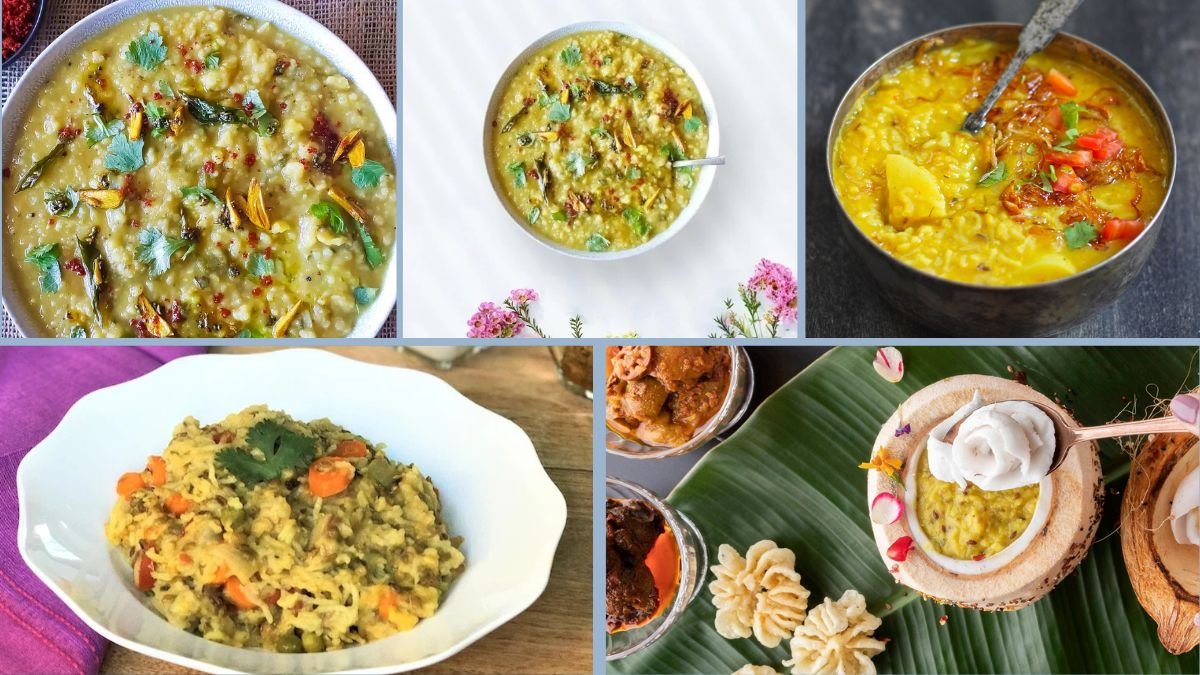When it comes to comfort food in Indian cuisine, few combinations can rival the soulful pairing of kadhi and khichdi. Simple, nourishing, and deeply satisfying, this duo has graced Indian households for centuries. Kadhi—a tangy yogurt-based curry thickened with gram flour (besan) and flavored with spices—pairs beautifully with khichdi, a wholesome one-pot dish of rice and lentils.
This combination is not just food; it’s an experience of balance. Kadhi brings a burst of tanginess and aromatic spices, while khichdi offers the grounding comfort of soft rice and lentils. Together, they are light on the stomach yet rich in nutrition.
In this article, we’ll explore a 6-step guide to cook kadhi and khichdi perfectly, focusing on techniques, balance of flavors, and presentation—so you can recreate this classic Indian comfort food at home with ease.
Step 1: Gathering Fresh and Essential Ingredients
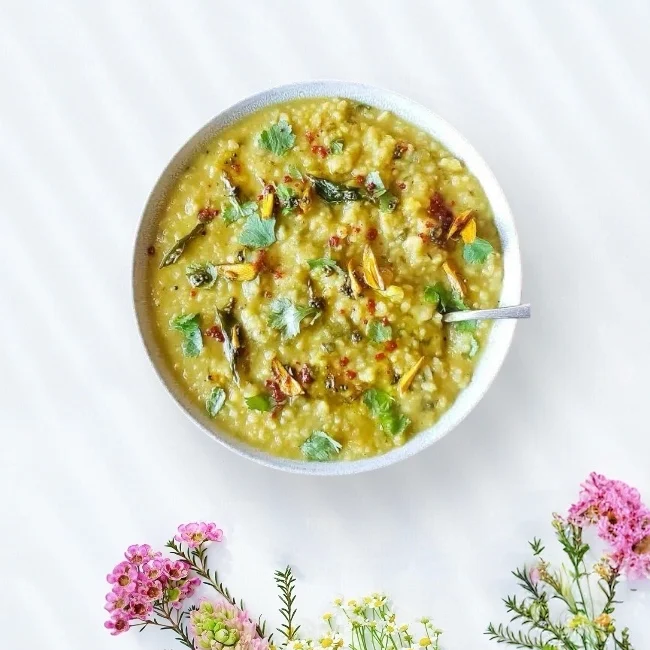
Cooking begins with choosing the right ingredients. Both kadhi and khichdi use simple staples found in every Indian pantry.
For Kadhi:
- Curd (yogurt): Slightly sour curd works best, as it gives kadhi its signature tang.
- Besan (gram flour): Acts as a thickener and balances the tang of yogurt.
- Spices: Turmeric, red chili powder, cumin seeds, fenugreek seeds, and coriander powder.
- Tempering: Mustard seeds, curry leaves, dry red chilies, ginger, and garlic.
- Oil or ghee: For authentic flavor.
For Khichdi:
- Rice: Short-grain rice like sona masoori or kolam works well.
- Lentils: Traditionally moong dal (yellow split gram), though toor dal (pigeon pea) can also be used.
- Spices & Aromatics: Cumin seeds, ginger, asafoetida (hing).
- Vegetables (optional): Carrot, beans, peas, and bottle gourd for a nutritious variation.
- Ghee or oil: For richness and aroma.
Pro Tip: Always wash rice and dal thoroughly to remove excess starch. Slightly roasting dal before cooking enhances aroma.
Step 2: Preparing the Yogurt-Besan Base for Kadhi
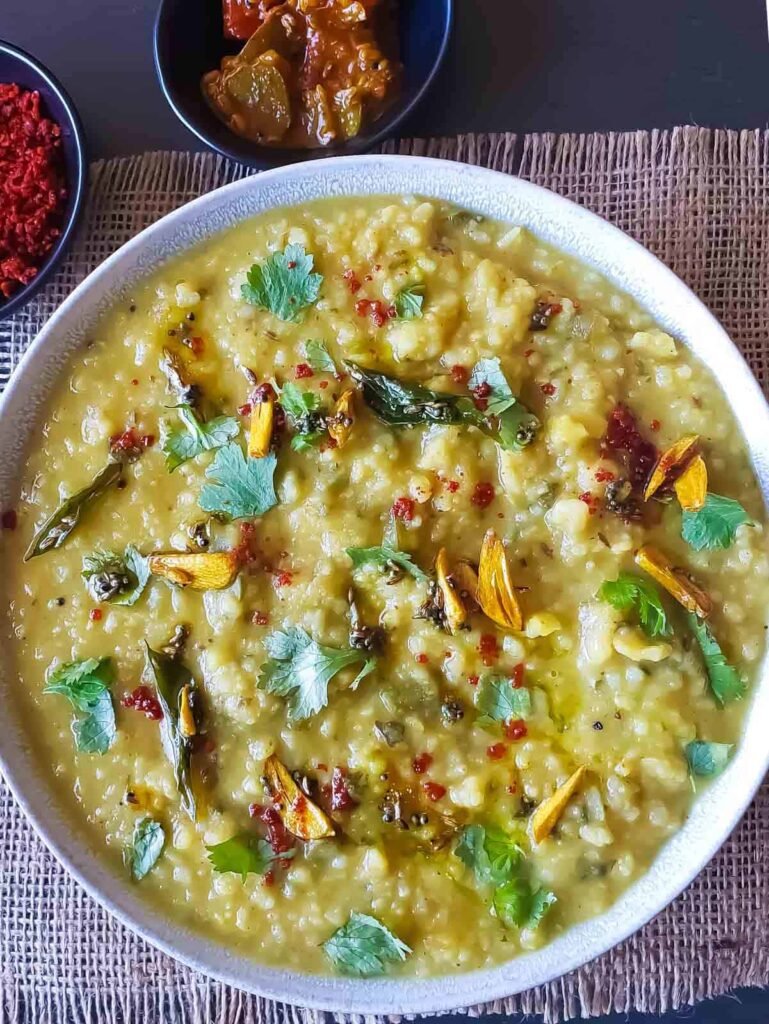
The secret to silky, lump-free kadhi lies in preparing the base correctly.
- In a mixing bowl, whisk together 1 cup curd with 2–3 tablespoons besan until smooth.
- Add 2–3 cups water gradually, whisking continuously. The mixture should be lump-free and of pouring consistency.
- Add turmeric powder, red chili powder, and salt to this mixture.
This base ensures kadhi cooks evenly and achieves the perfect balance of tanginess and creaminess without separating.
Pro Tip: Use slightly sour curd for authentic taste. Fresh curd makes kadhi too mild.
Step 3: Cooking the Kadhi
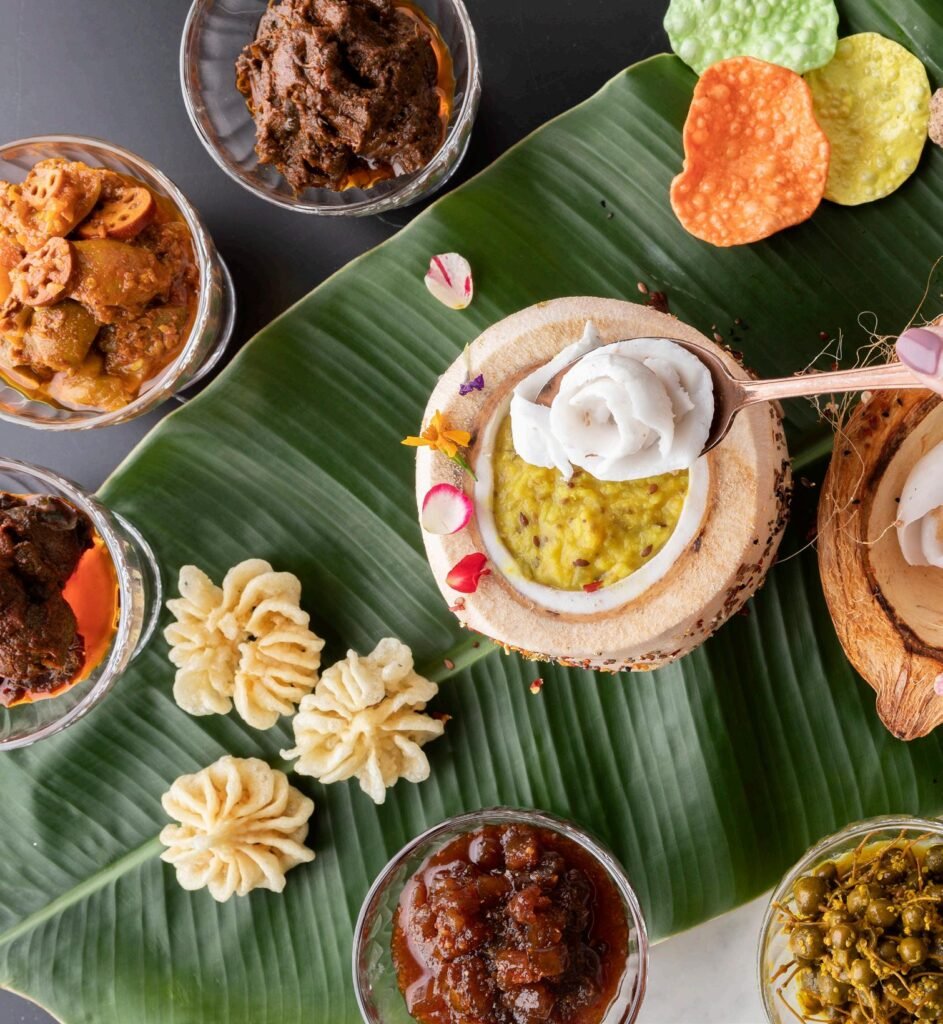
Now that the base is ready, it’s time to build flavors.
- Heat 1–2 tablespoons oil or ghee in a deep pan.
- Add cumin seeds, fenugreek seeds, and asafoetida. Let them splutter.
- Add chopped ginger, garlic, and green chilies. Sauté lightly.
- Slowly pour in the yogurt-besan mixture, stirring continuously to avoid curdling.
- Bring to a boil, then simmer for 20–25 minutes on low heat, stirring occasionally.
The kadhi should thicken slightly and turn creamy. The longer it simmers, the deeper the flavor.
Pro Tip: Stirring is important in the initial minutes; otherwise, the curd may split.
Step 4: Preparing the Khichdi
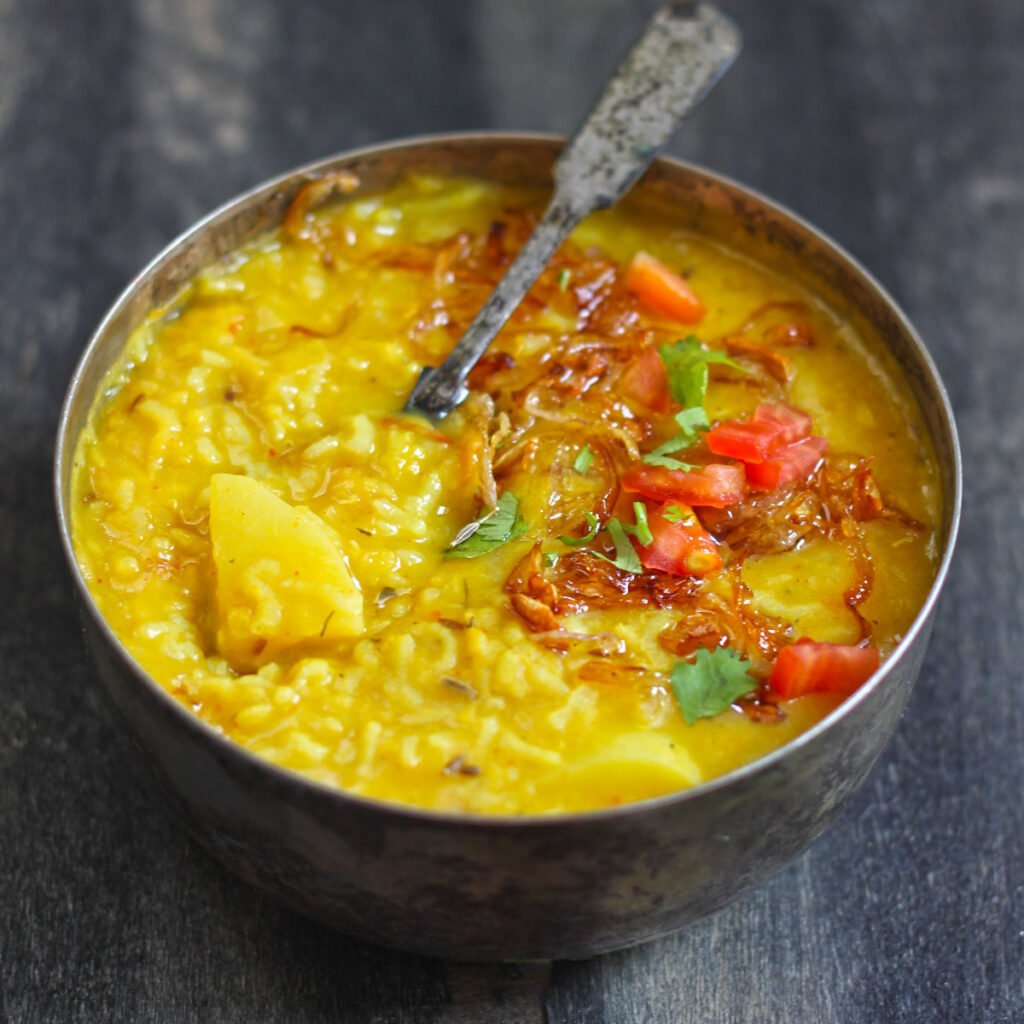
Khichdi is often underestimated as “simple rice and dal,” but when cooked with the right balance, it becomes deliciously wholesome.
- Wash and soak 1 cup rice and ½ cup moong dal for 20 minutes. Drain.
- Heat 1 tablespoon ghee in a pressure cooker or deep pan.
- Add cumin seeds, asafoetida, and chopped ginger. Sauté briefly.
- Add soaked rice and dal, stirring for 2–3 minutes to coat with ghee.
- Add 3–4 cups water, turmeric powder, and salt.
- Pressure cook for 3–4 whistles or simmer in a pan until soft and mushy.
For a richer version, add vegetables like peas, carrots, and beans while cooking.
Pro Tip: Adjust water depending on whether you like your khichdi thick (for roti pairing) or soft and runny (to go with kadhi).
Step 5: Tempering and Finishing Touches
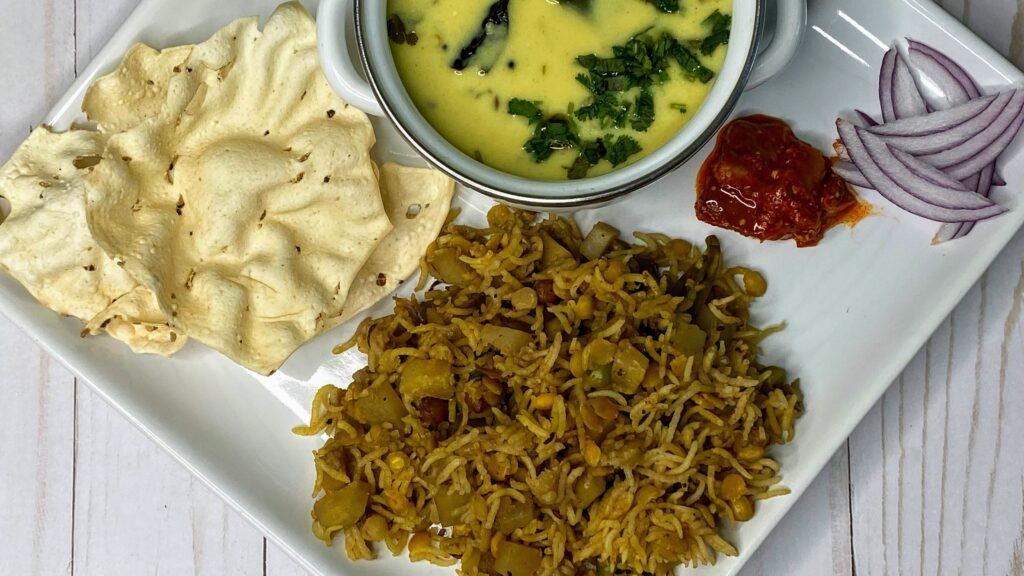
Tempering (tadka) elevates both kadhi and khichdi, transforming them from simple to memorable.
For Kadhi:
- Heat ghee in a small pan.
- Add mustard seeds, dry red chilies, and curry leaves.
- Pour over simmering kadhi just before serving.
For Khichdi:
- A drizzle of melted ghee on top before serving enhances flavor and aroma.
- Optionally, add fried onions or roasted cashews for a festive version.
Pro Tip: Always pour tadka hot and sizzling—it enhances aroma and presentation instantly.
Step 6: Serving the Kadhi Khichdi Combo
The final step is all about presentation and pairing.
- Serve hot khichdi in a bowl, topped with a spoon of ghee.
- Ladle kadhi into another bowl, garnished with coriander leaves and tempering.
- Accompaniments: papad, pickle, or a side salad of onions and cucumbers.
- For festive occasions, add pakoras (fritters) to the kadhi for richness.
Pro Tip: The balance lies in portion—take more khichdi for a filling base, and pour kadhi generously on top to soak in flavor.
Nutritional Benefits of Kadhi Khichdi
Beyond taste, this combo is also a powerhouse of nutrition:
- Khichdi provides complete protein (rice + dal combination), is easy to digest, and is perfect for recovery diets.
- Kadhi adds probiotics from curd, plant protein from besan, and digestive benefits from spices like fenugreek and cumin.
- Together, they make a balanced meal with carbohydrates, protein, probiotics, and micronutrients.
It’s no surprise that kadhi khichdi is often recommended for those recovering from illness or simply craving comfort food.
Common Mistakes to Avoid
- Curdling kadhi: Always add whisked curd mixture slowly and stir continuously.
- Undercooked khichdi: Soak dal and rice adequately; pressure cook for desired softness.
- Skipping tempering: Without tadka, flavors remain flat.
- Wrong consistency: Kadhi should be slightly thick but pourable; khichdi should be soft and moist, not dry.
- Overpowering spices: Kadhi is about balance; avoid overusing red chili or garam masala.
Conclusion
The Kadhi Khichdi combo is a timeless representation of Indian comfort food—simple, nourishing, and deeply satisfying. By following this **6-step guide—choosing fresh ingredients, preparing the base, cooking kadhi, preparing khichdi, adding tempering, and serving with care—**you can achieve a perfectly balanced meal every time.
What makes this duo special is its versatility. On a regular day, it’s wholesome everyday food; on special occasions, with pakoras in kadhi and accompaniments like papad, it becomes festive. It represents the beauty of Indian cooking—making the most of simple ingredients with the right techniques.
So, the next time you’re looking for a meal that brings both comfort and nourishment, look no further than kadhi khichdi. It’s a dish that satisfies the stomach, soothes the soul, and celebrates the wisdom of traditional Indian kitchens.
